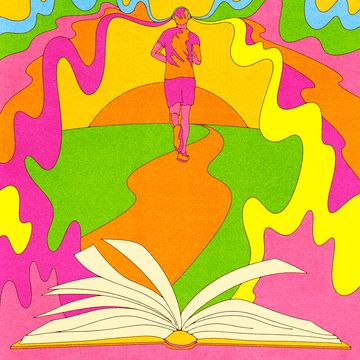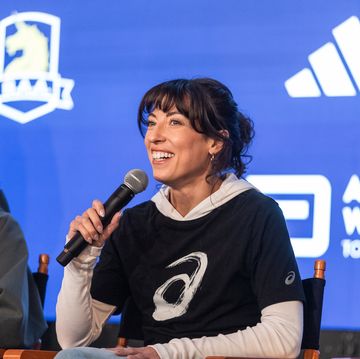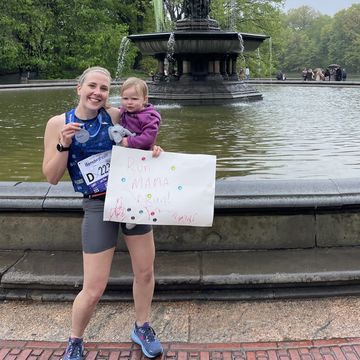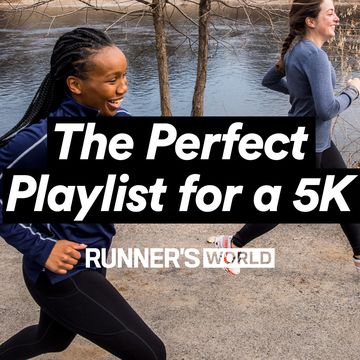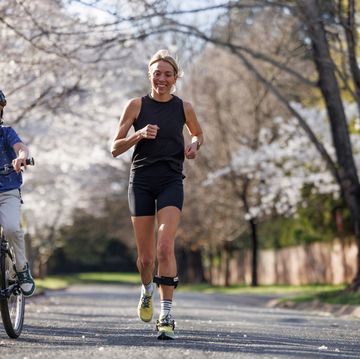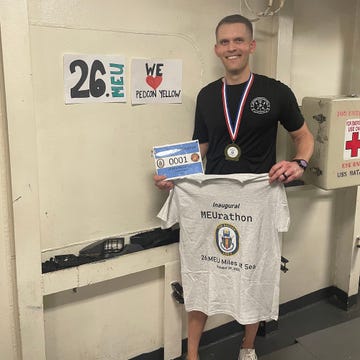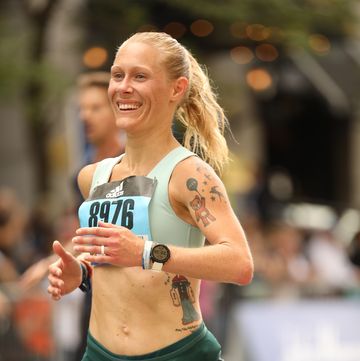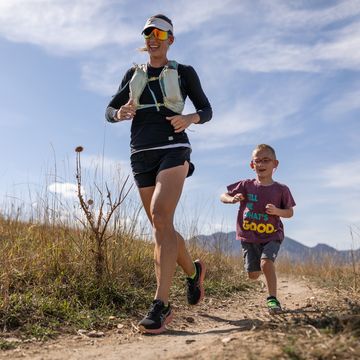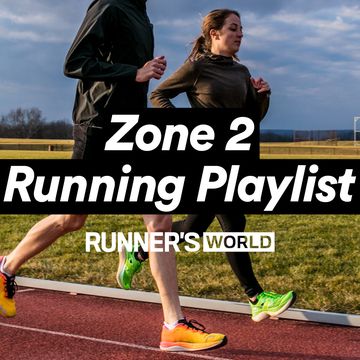In 2021—for the first time in World Marathon Major history—two of the biggest 26.2s in the world took place on back-to-back days. 26,112 runners crossed the finish line at the Chicago Marathon on Sunday, October 10, while even more tackled Heartbreak Hill at the Boston Marathon on Monday, October 11.
While most runners chose one or the other, California-native Matt Salminen had a different thought: why not run both?
→ Join Runner's World+ for access to exclusive marathon training plans!
Salminen, 32, has run nearly two dozen marathons, but he has special connections to Boston and Chicago. He lived in Boston for six years, completing five Boston Marathons for the Heartbreakers, the running club associated with the Heartbreak Hill Running Company. Salminen has run the last three iterations of the Chicago Marathon as well, also representing the Heartbreak Hill Running Company—which had recently opened up stores in the Windy City.
In correspondence with Runner’s World, Salminen breaks down his experience running two marathons on back-to-back days, including his training, flights, carb loads, and more.
Friday, October 8: Travel to Chicago
Afternoon—Irvine, California
As many people know, the carb-load starts about two to three days before a marathon. So on my way to the airport and on the plane to Chicago, I made sure keep hydrated and eat snacks.
My training block coming into these two marathons was a little bit different. Typically, I train for five to six months per training cycle. In this case, I was doing around the same time period of training, but I incorporated a lot of back-to-back long runs. This is a challenge that not many people take. It’s something that you have to train your body for.
My fastest time in the marathon is 2:38, so I was thinking it would be a good challenge to try to do both marathons under 2:45.
Evening—Chicago, Illinois
After landing, I went to a local restaurant, picked up pasta with sauce and bread, ate as much as I could, drank lots of water, and then went to sleep really, really early.
Saturday, October 9—The Day Before
Morning
I did a quick shakeout run in the morning around 9 a.m. My legs felt good. I didn’t have any major injuries during training, so I felt pretty fresh.
I went to the Chicago Marathon expo around 11 a.m. This year was a bit different from past years because of COVID-19. They had the same bib pickup at McCormick Place, but it took over an hour to get through the vaccine check. It really held up the lines, so I spent more time than usual at the expo, but definitely worth the experience.
Evening
In the evening after eating some more, I mentally planned my race, set up my race outfit, used my massage gun, and wished my friends good luck. I went to bed early.
Sunday, October 10—The Chicago Marathon
Morning
I felt a little nervous when I woke up for the marathon, considering all the months of training that I put in. I felt like, how am I going to do in these two marathons, considering they’re on back-to-back days? My best workout was two 20-mile long runs back-to-back, which gave me a lot of confidence that I could handle the distance.
I had three Maurten gels before the race, and I was ready to go. I had everything I needed.
The race started at 7:30 a.m., and I ran the first half pretty comfortably. The second half felt even more comfortable; I felt like I was just in rhythm. My training did really help; I felt like my endurance was there, and I took my gels at the right time. I ended up finishing 2:44:16, which put me in 200th place. I felt pretty good about it.
A lot of people talked about the weather in Chicago. I was sweating after the first couple miles, but so was everyone else. A lot of my good friends had a hard time. I was relatively fortunate that I did hold back because of Boston the next day. Conditions were definitely not ideal, but I was happy to finish and not overdo it.
Late morning
I think the most important aspect of the race is not only doing it, but finishing, and then making sure I was recovering as soon as possible. I didn’t know how my body was going to react. After running the first marathon, how can I run the second?
So after the first race, I immediately went back to the hotel, took a shower, cleaned up a little bit, used my massage gun, and took in a lot of fluids and electrolytes before leaving for the airport.
People asked me what I would eat after Chicago but before Boston—and I wasn’t planning on stuffing my face. For me, it was more important to replenish by drinking more liquids, because I didn’t want to eat too much the day before running Boston. I had a little pasta, but I took in much more electrolyte drinks. My stomach was a little unsettled after finishing Chicago, so I think it helped.
Evening—Boston, Massachusetts
I booked a flight as early as I could to get from Chicago to Boston. My flight left around 1 p.m., and when I landed, I went straight to pick up my bib around 5 p.m.
After I checked into my hotel, I made sure that I had enough time to get in more fluids and nutrition, put my legs up, set up everything I need to go in the morning, and get my mind ready. My quads felt sore, but I knew I felt like this during training. The weather was nice and cool, and I was pretty excited. I felt like I still had enough in the tank to give it a go.
I lived in Boston for six years, so being back, I knew I couldn’t back out of it. I had to do it.
Monday, October 11—The Boston Marathon
Morning
I caught the bus to the start line in Hopkinton at 7:15 a.m., and the race started at 9 a.m. I ran the first 10k thinking, let's see how the legs feel. I thought that under 2:50 would be an attainable goal. If I can hit the same time that I had in Chicago, that would be my all-time goal.
At the halfway mark at Wellesley tunnel, I was on pace for 2:50 to 2:52. My legs felt okay, but I was wondering if I could last another 13 miles because I’ve never run this much distance before. I remained confident, believing in the miles I did in training.
Around mile 17, when you start the Newton hills, I knew that my legs were going to take a lot of pounding. But I also knew that I've been training so hard for this, and I ran Boston in the past, and that you need to attack these hills to get them done. So that’s when I started to cut my pace down.
I conquered Heartbreak Hill, and pushed the pace after that; I got so excited that I felt so good and my legs were still moving, and I ran my last mile in 5:35. I ended up finishing the marathon in 2:49:05—under 2:50, which I planned. Not the same time as in Chicago, but definitely a good time after already running one marathon.
I was psyched to have a strong finish on Boylston Street. I saw a lot of friends and fellow runners on the road. I thought to myself, wow, I’ve accomplished so much. This was a challenge that meant a lot to me. It might not ever happen again in the future. Crossing that Boston finish line brought back a lot of memories of crossing Boston, but also realizing that I’ve done something that I didn't believe that I could do.
Evening
I celebrated by having a nice cold beer with some old friends from Boston, and watching the Red Sox win their playoff game.
I felt great, through all the training, logistics, flights, and races—I’m happy I put so much effort and time into it. Anyone that runs marathon majors has their own story, and I feel like this story is special to who I am as a runner.
Tuesday, October 12 — The Day After
Instead of going home to Irvine, I’m flying to France for vacation. My legs feel rough, but I don’t have any races coming up soon. I expected to break down a little bit, but I’m happy to have the battle scars.
Thinking back on my weekend, it felt great to be able to run these races and go back to normalcy. It's been over two years since Chicago and Boston were run. For everyone to be on the same roads running these races again and celebrating together, I felt a sense of unity. Marathons are back!
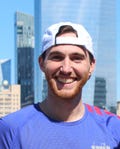
Chris Hatler is a writer and editor based in Philadelphia, Pennsylvania, but before joining Runner’s World and Bicycling, he was a pro runner for Diadora, qualifying for multiple U.S. Championships in the 1500 meters. At his alma mater the University of Pennsylvania, Chris was a multiple-time Ivy League conference champion and sub-4 minute miler.



